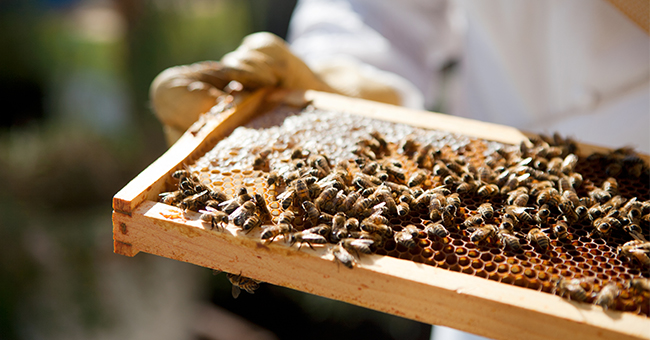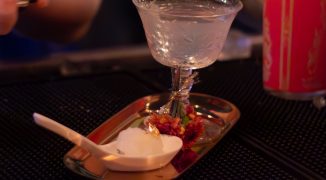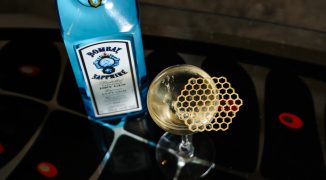As imbibers become more interested in the health implications of a drink’s ingredients, natural sweeteners have made a comeback. But the newest star in the ingredient list is actually an old favorite. Honey has been used to complement spirits and sweeten drinks since cocktail culture was in its infancy. As cocktails with honey are reassuming their role on upscale drink menus, some bars have gone a step further: the hives are on-site and the lines between beekeeper and bartender have been delightfully blurred.
Three progressive beehive bars – Polaris at the Hyatt Regency Atlanta, The Fairmont Olympic Hotel in Seattle and the Waldorf Astoria New York – have used their rooftop hives to create drink menus with a meaningful sense of place.
When Medhi Natanzi came to Polaris as the beverage director, he was tasked with reopening the iconic rotating restaurant. This meant creating the restaurant’s original cocktail program. Around that time, a truck carrying beehives through rural Georgia crashed, and Polaris’s executive chef saw the opportunity to rescue the hives by adding them to the hotel’s rooftop garden.
The roof hives and garden for Polaris started out with 2,000 bees from two hives. Today, they have anywhere from 40,000 to 60,000 bees in four hives. Two of those hives produce very distinct honey flavors: a lighter version similar to clover honey, and a dark-hued honey with a peppery finish to it.
Polaris was already growing cocktail ingredients in the garden, including a variety of mints, lavender, jalapeños, tomatoes, and scotch bonnet. Honey was a welcome addition to the natural ingredient list.
“The majority of cocktails out there use an artificial sweetener. They’re sugar bombs. There are some cocktails that need sweetness to hide any bite and honey is the perfect natural option,” Natanzi said.
At the Waldorf Astoria New York, mixologist Frank Caiafa can also find his favorite cocktail sweetener without leaving the building. The Waldorf’s rooftop honey, named “Top of the Waldorf,” is harvested on the 20th floor from the hotel’s 360,000 bees. “I usually prefer to use honey as the sugar component in a recipe. It has such an identifiable profile that comes through regardless of how much or how little you use. Honey takes to drier liquors like Armagnac and rye whiskey as well as more complementary spirits like bourbon or rum.”
Executive Chef Gavin Stephenson, the Fairmont Olympic Hotel, initially took an environmental interest in honeybees before combining his beekeeping skills with the menu. Now, the Fairmont has 18 hives on the roof.
 Executive Chef Gavin Stephenson of the Fairmont Olympic Hotel tends to his bees.
Executive Chef Gavin Stephenson of the Fairmont Olympic Hotel tends to his bees.
“I thought beekeeping looked cool but my real driver was the whole colony collapse issue. I needed to be part of the solution instead of just reading about it,” said Stephenson, who doubles as the sole beekeeper.
Both the rooftop hives and the specialized honey have been a huge hit with customers. “When Polaris rotates on the right position, you can look down at the garden. People love the fact that they can see the beehives the honey came from,” said Natazi.
The Fairmont Olympic held an off-the-cuff honey extraction party in the restaurant last July to show the public how their honey comes out of the comb. A crowd of 140 showed up to watch Stephenson extract 25 gallons of honey.
“People just can’t believe the honey came from the roof. They love the passion and local element. For example, we do a wildly popular honeybee breakfast at the restaurant. When we had the same breakfast without all of our honey, it wasn’t as popular,” added Stephenson.
The local honey adds such a distinct flavor to drinks that classic staples have once again become crowd favorites. At Polaris, the Prohibition-era Bee’s Knees cocktail gets a boost with Hayman’s gin, their light rooftop honey and fresh citrus. The Waldorf Astoria created the Wax Poetic, a spin on the Bee’s Knees that substitutes Zubrowka Bison Grass Vodka in the lead role for its lavender and coconut taste profile. The Waldorf Astoria’s next big cocktail unveiling will be the Bumbled Bee cocktail, a mix of rye whiskey, Salers Gentiane Aperitif, dry vermouth, honey syrup and both aromatic and orange bitters. In Seattle, Stephenson is busy perfecting the Fairmont’s Honey Collins – a gin and honey drink with a juniper effervescence.
 Cider is one of many things the Fairmont Olympic Hotel bar offers featuring honey harvested on the premises.
Cider is one of many things the Fairmont Olympic Hotel bar offers featuring honey harvested on the premises.
Honey also lends itself nicely to house beer, which both the Waldorf Astoria and Fairmont offer. The Waldorf collaborated with Empire Brewing to create two house beers out of their rooftop honey: the Waldorf Buzz and the Greatest of Them Ale. At the Fairmont Olympic Hotel, honey brewing grew out of a creative collaboration with Pike Brewery and has now expanded to include Seattle Cider.
The potential for including rooftop hive honey in different aspects of menus has only just begun to be realized. At the Fairmont, Stephenson is already breaking boundaries by figuring out how to incorporate more untraditional bee products into drinks, like pollen, honeycomb ice cubes and beeswax. If Polaris, the Waldorf and the Fairmont are any indication, mixologists and managers interested in beekeeping have limitless outlets for their creativity.




